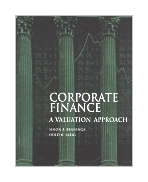|
||
• wydawnictwa polskie
• Zamów informacje o nowościach z wybranego tematu • kontakt
• Cookies na stronie |
CORPORATE FINANCE-A VALUATION APPROACHBENNINGA S.wydawnictwo: MCGRAW-HILL , rok wydania 2000, wydanie Icena netto: Corporate Finance A Valuation Approach Almost every undergraduate and graduate program in finance has a corporate finance course that extensively uses case analysis. These courses focus on the use of financial tools in valuation. However, there is a serious lack of integrated textual material for these courses. In Corporate Finance: A Valuation Approach we aim to fill this gap. Corporate Finance: A Valuation Approach is a self-contained, detailed description of the valuation process intended both for those who want to understand valuations and for those who plan to do valuations. Such an understanding can affect the handling of many aspects of the firm: the choice of strategic alliances, the selection among several possible lines of business, the combination of securities issued, and the design of compensation packages. The materials in Corporate Finance: A Valuation Approach have been classroom-tested extensively and used successfully with both MBAs and undergraduates. We have used the book both to accompany case courses in corporate finance and as an independent text. Extensive introductory material and an accompanying instructor's manual make the book completely self-contained. Corporate Finance: A Valuation Approach provides an integrated, comprehensive method of valuing assets, firms, and securities. We begin with a review of the financial and accounting techniques needed for the implementation of a full valuation. We proceed with a detailed discussion of the valuation process, leading the reader from the very first steps of building pro-forma financial statements, through the translation of these projections to values, to the division of firm value among the different security holders of the firm: shareholders, debt holders, and convertible security holders. Our book integrates the three most important elements required for valuation: 1 Consistent theoretical foundation to valuation. We give students a unified, operational, and theoretically consistent approach to valuation. The primary emphasis of Corporate Finance: A Valuation Approach is the discounted cash-flow (DCF) approach to valuation, which incorporates modem capital structure theory and market-based cost of capital models. We also discuss multiple-based valuation as an alternative to DCF, relating multiples to the same theoretical foundations as DCF. 2 Integrated structural approach to valuation. A structural approach to valuation inculcates an invaluable discipline, leading the student to understand all aspects of the firm- operational and financial. In the integrated approach of this book, the marketing and operating aspects of the firm are translated into an integrated pro-forma statement (a subject rarely discussed in finance textbooks), the risk characteristics of the firm are embedded into the discount rate and the valuation multiples, and the financial contracts issued by the firm determine how value is divided among the various claimants. 3 A series of consistent, worked-out applications. At every juncture we provide the student and the instructor with examples which are true to life, thoroughly worked out, and reflective of the underlying theory: In Chapter 2 we use IBM financial statements to illustrate the relation between accounting statements and cash flows. The hypothetical case of Hacker Computers illustrates the basic principles of financial accounting and their relation to finance theory. Our Motel Case in Chapter 3 gives a preliminary example of cash budgeting and the valuation process. We build a cash-flow statement for a small business and use this cashflow statement for valuation and for discussion of the effect of inflation and the use of multiples. In Chapter 4 we provide students with four easy-to-follow examples of pro-forma models. Each example illustrates a different aspect of the modeling techniques that make pro formas such a powerful tool. Our analysis of Acme Cleveland in Chapter 6 shows how to do a thorough financial statement analysis of a company and its industry. In Chapter 7 we show how J. M. Smucker Co. makes integrated use of techniques from three previous chapters. We construct a detailed pro-forma model which combines the formal aspects of pro-forma modeling (Chapter 4), an analysis of the firm's environment (Chapter 5), and a financial statement analysis (Chapter 6). In Chapter 9 we illustrate various methods of estimating the cost of capital using firms in the furniture industry as examples. In Chapter 10 we illustrate valuation by multiples using firms in the retail and airline industries. In Chapter 11 we illustrate the valuation of warrants using data from J. M. Smucker Co. and the valuation of convertible bonds using the Home Depot Inc. convertibles. Boeing is used to illustrate our calculation of debt securities value in Chapter 12. 444 pages Księgarnia nie działa. Nie odpowiadamy na pytania i nie realizujemy zamówien. Do odwolania !. |


